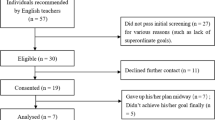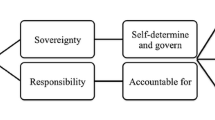Abstract
The concepts of learner engagement and directed motivational currents (DMCs) have recently gained attention for their value in generating a powerful and action-oriented motivational force that is able to cut through the various challenges and disturbances that language learners often face in their educational journey. DMCs, as a form of sustained engagement, describes a long-term experience of intense motivational energy with the aim of achieving a highly valued goal or vision that is characteristic of heightened levels of productivity. From an instructional perspective, therefore, an important aim would be to generate conditions that would lead to such outcomes. Following the framework developed by Dörnyei et al. (2016) for generating DMCs through group projects, the aim of this teacher-based research study was to identify whether learners in a university intensive English program could experience a DMC during an 8-week play performance project conducted in small groups. Focusing specifically on one of the groups and functioning within both a self-determination theory and complex dynamic systems perspective, the study also aimed to identify the combination of elements that contribute to and/or inhibit the development of a DMC. Based on learner data from project journals and conference interviews with the teacher-researcher, the findings indicate that the group experienced a DMC and was the result of a combination of and interaction between a variety of facilitative elements related to positive emotionality; self-concordant goals; goal/vision; a sense of competence, autonomy, and relatedness; and positive group dynamics, key project characteristics, teacher support, and positive outcomes in the form of language-related gains and personal growth. The facilitative elements, furthermore, operated to mitigate against the more attenuating elements represented in the learners’ challenges, fears, anxieties, group tensions, and distractions.
摘要
學習者投入和定向動機流(DMCs)的概念近來備受關注,因為它們能產生一種強大、以行動為導向的動力,讓學習者克服在教育歷程中經常面臨的各種挑戰與干擾。DMCs,作為一種持續的參與形式,描述了一種長期的、激烈的動機能量體驗,旨在達成具高度價值的目標或願景,以提高生產力為特色。因此,從教學的角度來看,其重要的目標就是要創造能促成這種結果的條件。根據Dörnyei、Henry和 Muir (2016)提出透過小組專題產生DMCs的框架,本研究以教師為中心,旨在確認一門大學的密集英語課程的學習者,能否在為期八週以小組為單位的戲劇表演專題中體驗到DMC。本研究建立在自我決定理論和複雜動態系統觀點之上,並特別關注課程的某一個小組,旨在確認有助於和/或抑制DMC發展因素的各種組合。根據專案日誌所搜集的學習者資料及和教師即研究者的會議訪談,研究結果顯示該小組體驗到了DMC,且是與正向情緒相關各種促進因素的組合和交互作用的結果: 自我協調目標;目標/願景; 能力感、自主感及關聯感;正向的團體動能、關鍵的專題特徵、教師支持及以語言相關的斬獲和個人成長為形式的正向結果。此外,這些促進因素還可以解緩學習者所面臨的挑戰、恐懼、焦慮、小組的緊張關係和分心等削弱性因素。


Similar content being viewed by others
Data Availability
Due to confidentiality agreements and to protect the privacy of study participants, data cannot be shared openly.
Notes
Perceptions of group dynamic were not measured in week 1 since the groups had just started working together.
References
Aarts, H., & Custers, R. (2012). Unconscious goal pursuit: Nonconscious goal regulation and motivation. In R. M. Ryan (Ed.), The Oxford handbook of human motivation (pp. 232–247). Oxford University Press.
Al-Hoorie, A. H., & Al-Shlowiy, A. (2020). Vision theory vs. goal-setting theory: A critical analysis. Porta Linguarum, 33, 217–229.
Barsade, S. G. (2002). The ripple effect: Emotional contagion and its influence on group behavior. Administrative Science Quarterly, 47, 644–675.
Csikszentmihalyi, M. (1990). Flow: The psychology of optimal experience. Harper and Row.
Csizer, K. (2019). The L2 motivational self system. In M. Lamb, K. Csizer, A. Henry & S. Ryan (Eds.), The Palgrage handbook of motivation for language learning (pp. 71–93). Basingstoke: Palgrave.
Dörnyei, Z. (2019b). Towards a better understanding of the L2 learning experience, the Cinderella of the L2 motivational self system. Studies in Second Language Learning and Teaching, 9, 19–30.
Dörnyei, Z. (2020). Innovations and challenges in language learning motivation. Routledge.
Dörnyei, Z., & Kubanyiova, M. (2014). Motivating learners, motivating teachers: Building vision in the language classroom. Cambridge University Press.
Dörnyei, Z., Henry, A., & Muir, C. (2016). Motivational currents in language learning: Frameworks for focused interventions. Routledge.
Dörnyei, Z. (2019a). From integrative motivation to directed motivational currents: The evolution of the understanding of L2 motivation over three decades. In M. Lamb, K. Csizer, A. Henry & S. Ryan (Eds.), The Palgrave handbook of motivation for language learning (pp. 39–69). Basingstoke: Palgrave.
Dweck, C. S. (2006). Mindset: The new psychology of success. Random House.
Frederickson, B. L. (2004). The broaden-and-build theory of positive emotions. Philosophical Transactions of the Royal Society of London, 359, 1367–1377.
Garcia-Pinar, A. (2022). Group directed motivational currents: Transporting undergraduates toward highly valued end goals. The Language Learning Journal, 50(5), 600–612. https://doi.org/10.1080/09571736.2020.1858144
Henry, A., Dörnyei, Z., & Davydenko, S. (2015). The anatomy of directed motivational currents: Exploring intense and enduring periods of L2 motivation. Modern Language Journal, 99, 329–345.
Hiver, P., & Papi, M. (2019). Complexity theory and L2 motivation. In M. Lamb, K. Csizer, A. Henry & S. Ryan (Eds.), The Palgrave handbook of motivation for language learning (pp. 117–137). Basingstoke: Palgrave.
Holliday, A. (2010). Analysing qualitative data. In B. Paltridge & A. Phakiti (Eds.), Continuum companion to research methods in applied linguistics (pp. 98–110). Continuum.
Ibrahim, Z. (2016). Affect in directed motivational currents: Positive emotionality in long-term L2 engagement. In P. MacIntyre, T. Gregersen, & S. Mercer (Eds.), Positive psychology in SLA (pp. 258–281). Multilingual Matters.
Jahedizadeh, S., & Al-Hoorie, A. H. (2021). Directed motivational currents: A systematic review. Studies in Second Language Learning and Teaching, 11(4), 517–541. https://doi.org/10.14746/ssllt.2021.11.4.3
Maley, A., & Duff, A. (2005). Drama techniques: A resource of communication activities for language teachers (3rd ed.). Cambridge University Press.
Mercer, S. (2019). Language learner engagement: Setting the scene. In X. A. Gao (Ed.), Second handbook of English language teaching (pp. 643–660). Springer.
Mercer, S., & Dörnyei, Z. (2020). Engaging language learners in contemporary classrooms. Cambridge University Press.
Muir, C. (2020). Directed motivational currents and language education: Exploring implications for pedagogy. Multilingual Matters.
Muir, C. (2016). The dynamics of intense long-term motivation in language learning: Directed motivational currents in theory and practice. (Doctoral dissertation), University of Nottingham, Nottingham, England.
Muir, C. (2019). Motivation and projects. In M. Lamb, K. Csizer, A. Henry & S. Ryan (Eds.), The Palgrave handbook of motivation for language learning (pp. 327–346). Basingstoke: Palgrave.
Noels, K. A., Lou, M. N., Vargas Lascano, D. I., Chaffee, K. E., Dincer, A., Zhang, Y. S. D., & Zhang, X. (2019). Self-determination and motivated engagement in language learning. In M. Lamb, K. Csizer, A. Henry & S. Ryan (Eds.), The Palgrave handbook of motivation for language learning (pp. 95–115). Basingstoke: Palgrave
Park, H., & Hiver, P. (2017). Profiling and tracing motivational change in project-based L2 learning. System, 67, 50–64.
Poupore, G. (2013). Task motivation in process: A complex systems perspective. The Canadian Modern Language Review, 69, 91–116.
Sak, M., & Gurbuz, N. (2022). Unpacking the negative side-effects of directed motivational currents in L2: An interpretative analysis. Language Teaching Research, Advance online publication October 15, 2022. https://doi.org/10.1177/13621688221125995
Sawyer, K. (2015). Group flow and group genius. NAMTA Journal, 40, 29–52.
Sinatra, G. M., Heddy, B. C., & Lombardi, D. (2015). The challenges of defining and measuring student engagement in science. Educational Psychologist, 50, 1–13.
Skinner, E. A., Kindermann, T. A., Connell, J. P., & Wellborn, J. G. (2009). Engagement and disaffection as organizational constructs in the dynamics of motivational development. In K. R. Wentzel & A. Wigfield (Eds.), Handbook of motivation at school (pp. 223–245). Taylor & Francis.
Zarrinabadi, N., & Khajeh, F. (2023). Describing characteristics of group-level directed motivational currents in EFL contexts. Current Psychology, 42, 1467–1476. https://doi.org/10.1007/s12144-021-01518-9
Author information
Authors and Affiliations
Corresponding author
Ethics declarations
Ethics Approval
Institutional Review Board (IRB) at Minnesota State University, Mankato, gave approval for the research, collection of data, and presentation/publication of results on September 21, 2018 (IRB# 1322638).
Consent to Participate
Informed consents were obtained from all participants involved in the study before the data collection began.
Competing Interests
The author declares no competing interests.
Appendix
Appendix
Rights and permissions
Springer Nature or its licensor (e.g. a society or other partner) holds exclusive rights to this article under a publishing agreement with the author(s) or other rightsholder(s); author self-archiving of the accepted manuscript version of this article is solely governed by the terms of such publishing agreement and applicable law.
About this article
Cite this article
Poupore, G. Learner Engagement, Directed Motivational Currents, and Project-Based Learning: A Pedagogical Intervention with English Learners. English Teaching & Learning (2024). https://doi.org/10.1007/s42321-024-00173-0
Received:
Revised:
Accepted:
Published:
DOI: https://doi.org/10.1007/s42321-024-00173-0
Keywords
- Motivation
- Engagement
- Directed motivational currents
- Project-based learning
- Self-determination theory
- Complex dynamic systems




